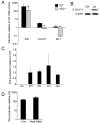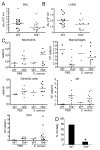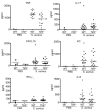Staphylococcus aureus induces type I IFN signaling in dendritic cells via TLR9
- PMID: 22962685
- PMCID: PMC3466375
- DOI: 10.4049/jimmunol.1201055
Staphylococcus aureus induces type I IFN signaling in dendritic cells via TLR9
Abstract
The importance of type I IFN signaling in the innate immune response to viral and intracellular pathogens is well established, with an increasing literature implicating extracellular bacterial pathogens, including Staphylococcus aureus, in this signaling pathway. Airway epithelial cells and especially dendritic cells (DCs) contribute to the production of type I IFNs in the lung. We were interested in establishing how S. aureus activates the type I IFN cascade in DCs. In vitro studies confirmed the rapid uptake of S. aureus by DCs followed promptly by STAT1 phosphorylation and expression of IFN-β. Signaling occurred using heat-killed organisms and in the absence of PVL and α-toxin. Consistent with the participation of endosomal and not cytosolic receptors, signaling was predominantly mediated by MyD88, TLR9, and IRF1 and blocked by cytochalasin D, dynasore, and chloroquine. To determine the role of TLR9 signaling in the pathogenesis of S. aureus pneumonia, we infected WT and Tlr9(-/-) mice with MRSA USA300. Tlr9(-/-) mice had significantly improved clearance of S. aureus from the airways and lung tissue. Ifnar(-/-) mice also had improved clearance. This enhanced clearance in Tlr9(-/-) mice was not due to differences in the numbers of recruited neutrophils into the airways, but instead correlated with decreased induction of TNF. Thus, we identified TLR9 as the critical receptor mediating the induction of type I IFN signaling in DCs in response to S. aureus, illustrating an additional mechanism through which S. aureus exploits innate immune signaling to facilitate infection.
Figures






Similar articles
-
Toll-like receptor 9-mediated protection of enterovirus 71 infection in mice is due to the release of danger-associated molecular patterns.J Virol. 2014 Oct;88(20):11658-70. doi: 10.1128/JVI.00867-14. Epub 2014 Jul 30. J Virol. 2014. PMID: 25078697 Free PMC article.
-
TLR9-dependent activation of dendritic cells by DNA from Leishmania major favors Th1 cell development and the resolution of lesions.J Immunol. 2009 Feb 1;182(3):1386-96. doi: 10.4049/jimmunol.182.3.1386. J Immunol. 2009. PMID: 19155485
-
Toll-like receptor 9 signaling in dendritic cells regulates neutrophil recruitment to inflammatory foci following Leishmania infantum infection.Infect Immun. 2015 Dec;83(12):4604-16. doi: 10.1128/IAI.00975-15. Epub 2015 Sep 14. Infect Immun. 2015. PMID: 26371124 Free PMC article.
-
TLR9 as a key receptor for the recognition of DNA.Adv Drug Deliv Rev. 2008 Apr 29;60(7):795-804. doi: 10.1016/j.addr.2007.12.004. Epub 2008 Jan 3. Adv Drug Deliv Rev. 2008. PMID: 18262306 Review.
-
Plasmacytoid dendritic cells in antiviral immunity and autoimmunity.Sci China Life Sci. 2010 Feb;53(2):172-82. doi: 10.1007/s11427-010-0045-0. Epub 2010 Mar 7. Sci China Life Sci. 2010. PMID: 20596824 Free PMC article. Review.
Cited by
-
Recognition of pathogen-associated nucleic acids by endosomal nucleic acid-sensing toll-like receptors.Acta Biochim Biophys Sin (Shanghai). 2013 Apr;45(4):241-58. doi: 10.1093/abbs/gms122. Epub 2013 Jan 30. Acta Biochim Biophys Sin (Shanghai). 2013. PMID: 23369718 Free PMC article. Review.
-
STING-Licensed Macrophages Prime Type I IFN Production by Plasmacytoid Dendritic Cells in the Bone Marrow during Severe Plasmodium yoelii Malaria.PLoS Pathog. 2016 Oct 28;12(10):e1005975. doi: 10.1371/journal.ppat.1005975. eCollection 2016 Oct. PLoS Pathog. 2016. PMID: 27792766 Free PMC article.
-
Mixtures of PRR Ligands Partly Mimic the Immunomodulatory Response of γi Staphylococcus aureus, Enhancing Osteogenic Differentiation of Human Mesenchymal Stromal Cells.Stem Cells Int. 2025 May 25;2025:1445520. doi: 10.1155/sci/1445520. eCollection 2025. Stem Cells Int. 2025. PMID: 40458752 Free PMC article.
-
Differential Induction of Type I and III Interferons by Staphylococcus aureus.Infect Immun. 2020 Sep 18;88(10):e00352-20. doi: 10.1128/IAI.00352-20. Print 2020 Sep 18. Infect Immun. 2020. PMID: 32690637 Free PMC article.
-
The Influence of Antibiotic Resistance on Innate Immune Responses to Staphylococcus aureus Infection.Antibiotics (Basel). 2022 Apr 19;11(5):542. doi: 10.3390/antibiotics11050542. Antibiotics (Basel). 2022. PMID: 35625186 Free PMC article. Review.
References
-
- Kollef MH, Shorr A, Tabak YP, Gupta V, Liu LZ, Johannes RS. Epidemiology and outcomes of health-care-associated pneumonia: results from a large US database of culture-positive pneumonia. Chest. 2005;128:3854–3862. - PubMed
-
- Klevens RM, Morrison MA, Nadle J, Petit S, Gershman K, Ray S, Harrison LH, Lynfield R, Dumyati G, Townes JM, Craig AS, Zell ER, Fosheim GE, McDougal LK, Carey RB, Fridkin SK. Invasive methicillin-resistant Staphylococcus aureus infections in the United States. JAMA. 2007;298:1763–1771. - PubMed
-
- Finelli L, Fiore A, Dhara R, Brammer L, Shay DK, Kamimoto L, Fry A, Hageman J, Gorwitz R, Bresee J, Uyeki T. Influenza-associated pediatric mortality in the United States: increase of Staphylococcus aureus coinfection. Pediatrics. 2008;122:805–811. - PubMed
Publication types
MeSH terms
Substances
Grants and funding
LinkOut - more resources
Full Text Sources
Molecular Biology Databases
Research Materials
Miscellaneous

